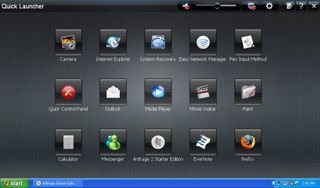An Exclusive Look at the CTL 2go Tablet (or Intel Classmate Netvertible)

Back in August, at the Intel Developer's Forum we got a first look at the early Classmate tablet or "netvertible." At the time, Intel detailed that they would be brought to market by OEMS at the end of 2008.
CTL, who has brought to market Intel's second generation Classmate under the name 2go PC, is planning to sell the small tablet in the coming months and sent us its single demo unit for a few days of hands-on treatment. The unit they sent is a DVT sample and the hardware is nowhere near final. The coloring is a bit off and the build isn't all that sturdy, but it didn't stop us from getting a glimpse at what seems to be the first tablet netbook to hit the U.S. market.
The company plans to sell a very limited supply starting in mid-December (it will be in retail channels in January 2009) for a starting price of $499. The specs are similar to what Engadget reported a few weeks back: The 8.9-inch system packs a 1.6GHz Atom 270 processor, 1GB of RAM, 60GB HDD and 802.11b/g/n WiFi. The final version will also come with a 6-cell battery (our test unit has a 4-cell). According to CTL, pricing is still being worked out. The hardware without an OS will cost $499. The Ubuntu Linux version will retail for that price, but we assume the Windows XP Home version will be about $50 more.
Below are our first impressions of the device and the touch experience.
Small Build, Cramped Keyboard
Since the design of our system is not final we don't want to dwell on our impressions of the hardware feel. However the yellow-lime green lid reminds us of a hospital sheets and we really hope that CTL goes with the royal blue look that we saw at IDF. The build is quite small and is only slightly longer than the Dell Mini 9. The 2go tablet has 2 USB ports, VGA out, Ethernet, an SD card slot, and a mic and headphone jack.
Our only hesitation about the hardware at this point is the cramped keyboard. Similar to the keyboard on the 2go PC, it is just too small for adult rapid touch typists, but probably just right for kids. However we do like that it is spill-resistant. The touchpad is a good size and the mouse buttons are comfortable, though a bit mushy.
Stay in the know with Laptop Mag
Get our in-depth reviews, helpful tips, great deals, and the biggest news stories delivered to your inbox.
Durability
The 2go tablet is also one of the most durable netbooks we have come across (even though it doesn't come with an SSD right now). Beyond the spill-resistant keyboard, the bottom edge has a rubber bump for falls. The hard drive is shock mounted. For extra care, the system comes with an attached handle but it can be removed by taking off the battery and unscrewing it.
Touch Goodness
Obviously the 2go tablet's stand out feature is its 8.9-inch 1024 x 600 resolution screen, resistive touch screen. The display is responsive to both finger and pen input. Since CTL didn't include a stylus in our unit (there is a holder for it on the right edge) we relied heavily on our finger and didn't find ourselves getting frustrated.
Intel has created a Quick Launcher that is similar to an easy mode on top of a Linux OS (the Dell Ubuntu skin comes to mind). The launcher contains shortcuts to a number of preloaded applications, including Internet Explorer and Windows Media Player (others can be easily added). We found the launcher to be a nice addition, especially on such a small screen where small icons are hard to pinpoint with a finger.

Because the Windows XP Home OS is not meant for tablet use, we had to install a few of our own freeware programs to take full advantage of the touchscreen. For instance installing Grab and Drag’s Firefox add-on allowed us to use a finger in the browser. We swiped down the page to scroll and tapped the back button to navigate. Intel also preloads ArtRage a neat art program; shading and scribbling with our finger was responsive, not to mention fun.
Of course, the hope is that kids will use the touch screen to take notes. When we launched Evernote and dug up a stylus from another system, we took some notes, but had to press down a bit harder than we would have liked with the stylus to make sure all our letters appeared clearly.
Responsive Accelerometer
One of our biggest complaints about the Gigabyte M912, the only other netbook with touch we have tested, was that it didn't have a built in accelerometer. An annoying piece of software was required to change the orientation of the screen. The 2go tablet on the other hand adjusts the screen orientation by just turning the netbook. As you will see in the video it is very responsive and makes for easily converting the system into a slate.
Early Verdict
Until we get a look at ASUS' touchscreen Eee PCs we can firmly say the 2go tablet looks to be the most promising netbook with tablet capabilities on the market. Though the keyboard is an area of concern, its durable features, accelerometer and responsive touchscreen are all compelling for a $500 price. However, to make our final assessment, we will need to get a production unit.
[flq:3754faf8e0154074812cd895aeb964e1]
